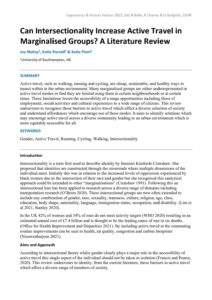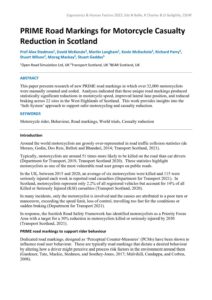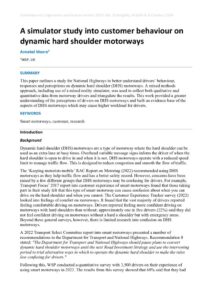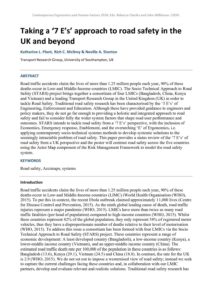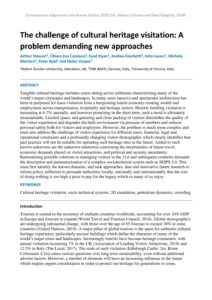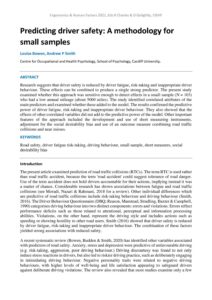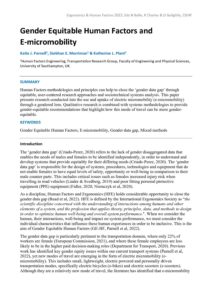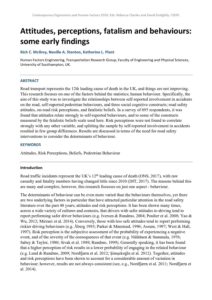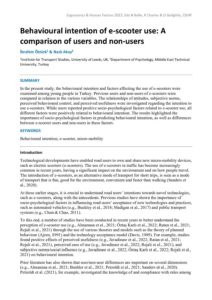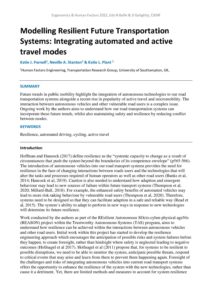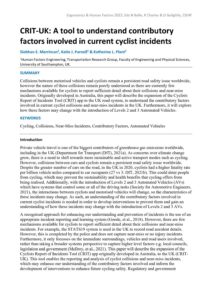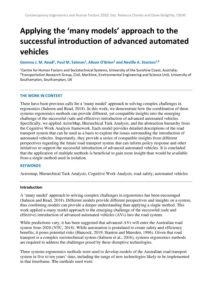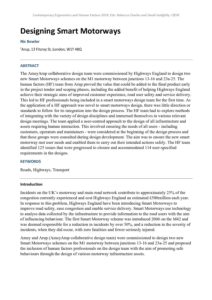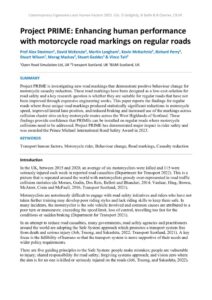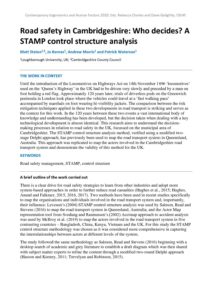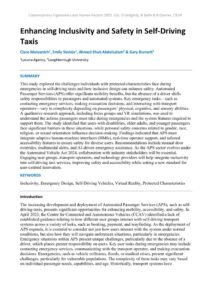Road safety
Can Intersectionality Increase Active Travel in Marginalised Groups? A Literature Review
| Document | Author Joy McKay, Katie Parnell & Katie Plant |
| Abstract Active travel, such as walking, running and cycling, are cheap, sustainable, and healthy ways to transit within in the urban environment. Many marginalised groups are either underrepresented in active travel modes or find they are limited using them in certain neighbourhoods or at certain times. These limitations lessen the accessibility of a range opportunities including those of employment, social activities and cultural experiences to a wide range of citizens. This review endeavours to recognise those barriers to active travel which affect a diverse selection of society and understand affordances which encourage use of these modes. It aims to identify solutions which may encourage active travel across a diverse community leading to an urban environment which is more equitably accessible for all. |
PRIME Road Markings for Motorcycle Casualty Reduction in Scotland
| Document | Author Prof Alex Stedmon, David McKenzie, Martin Langham, Kevin McKechnie, Richard Perry, Stuart Wlison, Morag Mackay, Stuart Geddes |
| Abstract This paper presents research of new PRIME road markings in which over 32,000 motorcyclists were manually counted and coded. Analyses indicated that these unique road markings produced statistically significant reductions in motorcycle speed, improved lateral lane position, and reduced braking across 22 sites in the West Highlands of Scotland. This work provides insights into the ‘Safe System’ approach to support safer motorcycling and casualty reduction. |
A simulator study into customer behaviour on dynamic hard shoulder motorways
| Document | Author Annabel Moore |
| Abstract This paper outlines a study for National Highways to better understand drivers’ behaviour, responses and perceptions on dynamic hard shoulder (DHS) motorways. A mixed methods approach, including use of a mixed reality simulator, was used to collect both qualitative and quantitative data from motorway drivers and triangulate the results. This work provided a greater understanding of the perceptions of drivers on DHS motorways and built an evidence base of the aspects of DHS motorways which may cause higher workload for drivers. |
Taking a ‘7 E’s’ approach to road safety in the UK and beyond
| Document | Author Katherine L. Plant, Rich C. McIlroy & Neville A. Stanton |
| Abstract Road traffic accidents claim the lives of more than 1.25 million people each year, 90% of these deaths occur in Low-and Middle-Income countries (LMIC). The Socio Technical Approach to Road Safety (STARS) project brings together a consortium of four LMICs (Bangladesh, China, Kenya and Vietnam) and a leading Transport Research Group in the United Kingdom (UK) in order to tackle Road Safety. Traditional road safety research has been characterised by the ‘3 E’s’ of Engineering, Enforcement and Education. Although these have provided guidance to engineers and policy makers, they do not go far enough to providing a holistic and integrated approach to road safety and fail to consider fully the wider system factors that shape road user performance and outcomes. STARS intends to tackle road safety from a ‘7 E’s’ perspective, with the inclusion of Economics, Emergency response, Enablement, and the overarching ‘E’ of Ergonomics, i.e. applying contemporary socio-technical systems methods to develop systemic solutions to the seemingly intractable problem of road safety. This paper provides a status review of the ‘7 E’s’ of road safety from a UK perspective and the poster will contrast road safety across the five countries using the Actor Map component of the Risk Management Framework to model the road safety system. |
The challenge of cultural heritage visitation: A problem demanding new approaches
| Document | Author Arthur Stewart, Chiara Eva Catalano, Eyad Elyan, Andrea Giachetti, John Isaacs, Michela Mortara, Peter Reid and Helen Vosper |
| Abstract Tangible cultural heritage includes assets dating across millennia characterising many of the world’s major cityscapes and landscapes. In many cases massive and spectacular architecture has been re-purposed for mass-visitation from a burgeoning tourist economy creating wealth and employment across transportation, hospitality and heritage sectors. Historic building visitation is increasing at 6-7% annually, and however promising in the short term, such a trend is ultimately unsustainable. Limited space, and queueing and close packing of visitors diminishes the quality of the visitor experience and degrades the built environment via pressure of numbers and reduces personal safety both for visitors and employees. However, the problem is much more complex and must also address the challenge of visitor experience for different users, financial, legal and operational constraints and a profoundly changing visitor-demographic which clearly identifies that past practice will not be suitable for operating such heritage sites in the future. Added to such known unknowns are the unknown unknowns concerning the uncertainties of future travel, economic demands placed on visitor attractions, and political and security uncertainty. Rationalising possible solutions to managing visitors in the 21st and subsequent centuries demands the description and parameterisation of a complex-sociotechnical system such as SEIPS 2.0. This must first identify the known domains, and seek approaches, data and innovative future research to inform policy sufficient to persuade authorities locally, nationally and internationally that the cost of doing nothing is too high a price to pay for the legacy which so many of us enjoy. |
Predicting driver safety: A methodology for small samples
| Document | Author Louise Bowen and Andrew P Smith |
| Abstract Research suggests that driver safety is reduced by driver fatigue, risk-taking and inappropriate driver behaviour. These effects can be combined to produce a single strong predictor. The present study examined whether this approach was sensitive enough to detect effects in a small sample (N = 103) who had a low annual mileage (about 5000 miles). The study identified correlated attributes of the main predictors and examined whether these added to the model. The results confirmed the predictive power of driver fatigue, risk-taking and inappropriate driver behaviour. They also showed that the effects of other correlated variables did not add to the predictive power of the model. Other important features of the approach included the development and use of short measuring instruments, adjustment for the social desirability bias and use of an outcome measure combining road traffic collisions and near misses. |
Gender Equitable Human Factors and E-micromobility
| Document | Author Katie J. Parnell, Siobhan E. Merriman & Katherine L. Plant |
| Abstract Human Factors methodologies and principles can help to close the ‘gender data gap’ through equitable, user-centered research approaches and sociotechnical systems analysis. This paper presents research conducted into the use and uptake of electric micromobility (e-micromobility) through a gendered lens. Qualitative research is combined with systems methodologies to provide gender-equitable recommendations that highlight how this mode of travel can be more gender-equitable. |
It’s not all about the bike: distributed situation awareness and teamwork in elite women’s cycling teams
| Document | Author Paul SALMON, Clare DALLAT, Amanda CLACY |
| Abstract This paper presents the findings from a study examining situation awareness and teamwork in elite women’s cycling. This involved observing an elite racing team during two Australian National Road Series race events and conducting post-race critical decision method interviews. The data were analyzed using the Event Analysis of Systemic Teamwork framework to show the task, social and situation awareness networks underpinning team performance. The findings are discussed in relation to enhancing cycling team performance and potential applications in other sports. |
Attitudes, perceptions, fatalism and behaviours: some early findings
| Document | Author Rich C. McIlroy, Neville A. Stanton, Katherine L. Plant |
| Abstract Road transport represents the 12th leading cause of death in the UK, and things are not improving. This research focuses on one of the factors behind the statistics; human behaviour. Specifically, the aim of this study was to investigate the relationships between self-reported involvement in accidents on the road, self-reported pedestrian behaviours, and three social cognitive constructs; road safety attitudes, on-road risk perceptions, and fatalistic beliefs. In a survey of 695 respondents, it was found that attitudes relate strongly to self-reported behaviours, and to some of the constructs measured by the fatalistic beliefs scale used here. Risk perceptions were not found to correlate strongly with any other variable, and splitting the sample by self-reported involvement in accidents resulted in few group differences. Results are discussed in terms of the need for road safety interventions to consider the determinants of behaviour. |
Behavioural intention of e-scooter use: A comparison of users and non-users
| Document | Author İbrahim Öztürk & Nazlı Akay |
| Abstract In the present study, the behavioural intention and factors affecting the use of e-scooters were examined among young people in Turkey. Previous users and non-users of e-scooters were compared in relation to the various variables. The relationships of attitudes, subjective norms, perceived behavioural control, and perceived usefulness were investigated regarding the intention to use e-scooters. While users reported positive socio-psychological factors related to e-scooter use, all different factors were positively related to behavioural intention. The results highlighted the importance of socio-psychological factors in predicting behavioural intention, as well as differences between e-scooter users and non-users in these factors. |
Modelling Resilient Future Transportation Systems: Integrating automated and active travel modes
| Document | Author Katie J. Parnell, Neville A. Stanton & Katie L. Plant |
| Abstract Future trends in public mobility highlight the integration of autonomous technologies to our road transportation systems alongside a recent rise in popularity of active travel and micromobility. The interaction between autonomous vehicles and other vulnerable road users is a complex issue. Ongoing work by the authors aims to understand how our road transportation systems can incorporate these future trends, whilst also maintaining safety and resilience by reducing conflict between modes. |
CRIT-UK: A tool to understand contributory factors involved in current cyclist incidents
| Document | Author Siobhan E. Merriman, Katie J. Parnell & Katherine L. Plant |
| Abstract Collisions between motorised vehicles and cyclists remain a persistent road safety issue worldwide, however the nature of these collisions remain poorly understood as there are currently few mechanisms available for cyclists to report sufficient detail about their collisions and near-miss incidents. Originally developed in Australia, this paper will describe the expansion of the Cyclists Report of Incidents Tool (CRIT) app to the UK road system, to understand the contributory factors involved in current cyclist collisions and near-miss incidents in the UK. Furthermore, it will explore how these factors may change with the introduction of Levels 2 and 3 Automated Vehicles. |
Applying the ‘many models’ approach to the successful introduction of advanced automated vehicles
| Document | Author Gemma J. M. Read, Paul M. Salmon, Alison O’Brien and Neville A. Stanton |
| Abstract There have been previous calls for a ‘many model’ approach to solving complex challenges in ergonomics (Salmon and Read, 2018). In this work, we demonstrate how the combination of three systems ergonomics methods can provide different, yet compatible insights into the emerging challenge of the successful (safe and effective) introduction of advanced automated vehicles. Specifically, we applied ActorMap, Hierarchical Task Analysis, and the abstraction hierarchy from the Cognitive Work Analysis framework. Each model provides detailed descriptions of the road transport system that can be used as a basis to explore the issues surrounding the introduction of automated vehicles. Importantly, they provide a series of compatible insights from different perspectives regarding the future road transport system that can inform policy response and other initiatives to support the successful introduction of advanced automated vehicles. It is concluded that the application of multiple methods is beneficial to gain more insight than would be available from a single method used in isolation. |
Designing Smart Motorways
| Document | Author Nic Bowler |
| Abstract The AmeyArup collaborative design team were commissioned by Highways England to design two new Smart Motorways schemes on the M1 motorway between junctions 13-16 and 23a-25. The human factors (HF) team from Arup proved the value that could be added to the final product early in the project tender and scoping phases, including the added benefit of helping Highways England achieve their strategic aims of improved customer experience, road user safety and service delivery. This led to HF professionals being included in a smart motorways design team for the first time. As the application of a HF approach was novel to smart motorways design, there was little direction or standards to follow for its integration into the design process. The HF team had to explore methods of integrating with the variety of design disciplines and immersed themselves in various relevant design meetings. The team applied a user-centred approach to the design of all infrastructure and assets requiring human interaction. This involved ensuring the needs of all users - including customers, operators and maintainers - were considered at the beginning of the design process and that these groups were consulted during design development. The aim was to ensure the new smart motorway met user needs and enabled them to carry out their intended actions safely. The HF team identified 125 issues that were progressed to closure and accommodated 114 user-specified requirements in the designs. |
Project PRIME: Enhancing human performance with motorcycle road markings on regular roads
| Document | Author Alex Stedmon, David McKenzie, Martin Langham, Kevin McKechnie, Richard Perry, Stuart Wlison, Morag Mackay, Stuart Geddes & Vince Tait |
| Abstract Project PRIME is investigating new road markings that demonstrate positive behaviour change for motorcycle casualty reduction. These road markings have been designed as a low-cost solution for road safety and a key research question is whether they are suitable for regular roads that have not been improved through expensive engineering works. This paper reports the findings for regular roads where these unique road markings produced statistically significant reductions in motorcycle speed, improved lateral lane position, and reduced braking and increased use of the markings across collision cluster sites on key motorcycle routes across the West Highlands of Scotland. These findings provide confidence that PRIMEs can be installed on regular roads where motorcycle collisions need to be addressed. Project PRIME has demonstrated major impact in rider safety and was awarded the Prince Michael International Road Safety Award in 2023. |
Road safety in Cambridgeshire: Who decides? A STAMP control structure analysis
| Document | Author Matt Staton, Jo Barnes, Andrew Morris and Patrick Waterson |
| Abstract Until the introduction of the Locomotives on Highways Act on 14th November 1896 ‘locomotives’ used on the ‘Queen’s Highway’ in the UK had to be driven very slowly and preceded by a man on foot holding a red flag. Approximately 120 years later, trials of driverless pods on the Greenwich peninsula in London took place where the vehicles could travel at a ‘fast walking pace’ accompanied by marshals on foot wearing hi-visibility jackets. The comparison between the risk mitigation techniques applied in these two developments in road transport is striking and serves as the context for this work. In the 120 years between these two events a vast international body of knowledge and understanding has been developed, but the decision taken when dealing with a key technological development is almost identical. This research aims to understand the decision-making processes in relation to road safety in the UK, focussed on the municipal area of Cambridgeshire. The STAMP control structure analysis method, verified using a modified two-stage Delphi approach, has previously been used to map the road transport system in Queensland, Australia. This approach was replicated to map the actors involved in the Cambridgeshire road transport system and demonstrate the validity of this method for the UK. |
Enhancing Inclusivity and Safety in Self-Driving Taxis
| Document | Author Clare Mutzenich, Emily Stobbs, Ahmed Ehab Abdelsalam & Gary Burnett |
| Abstract This study explored the challenges individuals with protected characteristics face during emergencies in self-driving taxis and how inclusive design can enhance safety. Automated Passenger Services (APS) offer significant mobility benefits, but the absence of a driver shifts safety responsibilities to passengers and automated systems. Key emergency tasks—such as contacting emergency services, making evacuation decisions, and interacting with transport operators—vary in complexity depending on passengers’ physical, cognitive, and sensory abilities. A qualitative research approach, including focus groups and VR simulations, was used to understand the actions passengers must take during emergencies and the system features required to support them. The study identified that users with disabilities, older adults, and younger passengers face significant barriers in these situations, while personal safety concerns related to gender, race, religion, or sexual orientation influence decision-making. Findings indicated that APS must integrate adaptive human-machine interfaces (HMIs), real-time operator support, and tailored accessibility features to ensure safety for diverse users. Recommendations include manual door overrides, multimodal alerts, and AI-driven emergency assistance. As the APS sector evolves under the Automated Vehicle Act 2024, collaboration with industry stakeholders will be essential. Engaging user groups, transport operators, and technology providers will help integrate inclusivity into self-driving taxi services, improving safety and accessibility while setting a new standard for user-centred innovation. |
Design induced non-compliance: influences on pedestrian and cyclist behaviour at level crossings
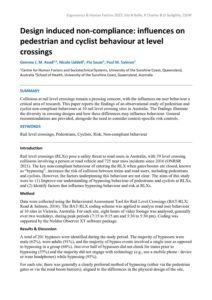
| Document
Insert here |
Author Gemma J. M. Read, Nicole Liddell, Pia Sauer & Paul M. Salmon |
| Abstract Collisions at rail level crossings remain a pressing concern, with the influences on user behaviour a critical area of research. This paper reports the findings of an observational study of pedestrian and cyclist non-compliant behaviours at 10 rail level crossing sites in Australia. The findings illustrate the diversity in crossing designs and how these differences may influence behaviour. General recommendations are provided, alongside the need to consider context-specific risk controls. |

